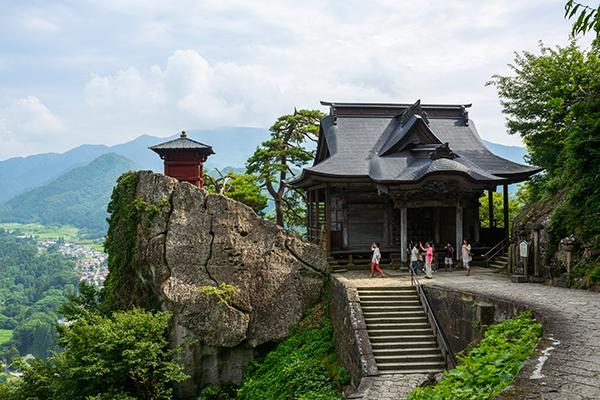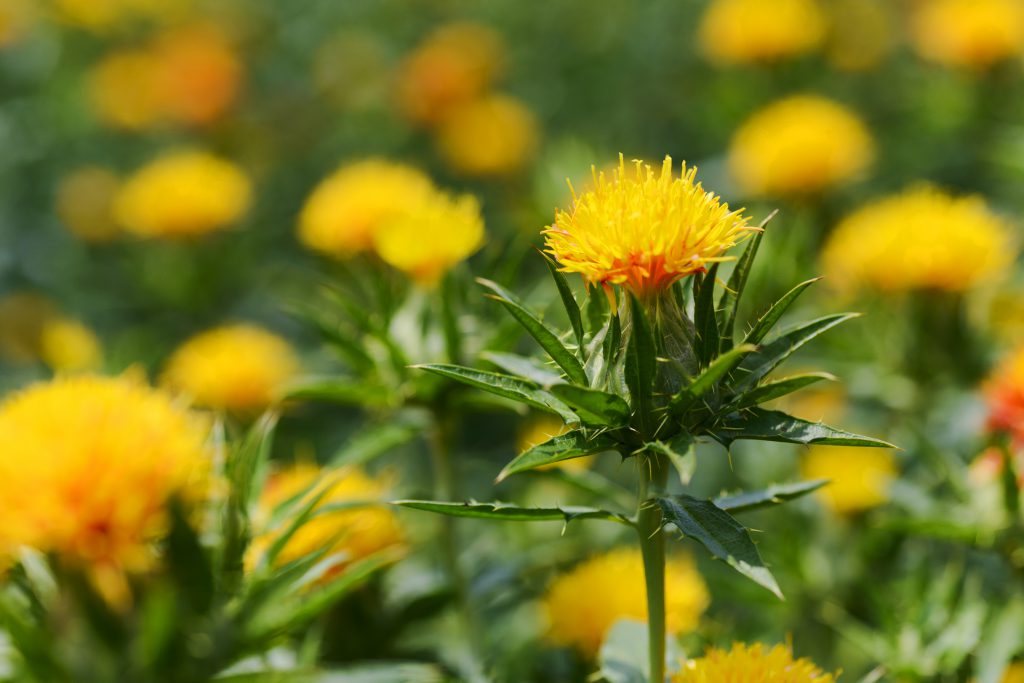Story
The value of Mogami Safflower is 100 times that of rice, 10 times that of gold
The value of Mogami Safflower is 100 times that of rice, 10 times that of gold.
Bringing tremendous wealth, the safflower became the cornerstone of economic and cultural development.

The safflower is designated as Yamagata Prefecture’s prefectural flower. Large quantities of safflower pollen were discovered in the Makimuku ruins in Nara Prefecture, which date back to the 3rd century, and it is thought that the safflower had been brought to Japan around this time.
The area located in the middle basin of the Mogamigawa River, centering around the Murayama region of Yamagata Prefecture, has grown into Japan’s largest safflower producing region, thanks to the fertile soil and climate where morning mists frequently occur. Referred to as Mogami-Senda,* the huge volume of safflowers produced was recorded to have accounted for approximately half of Japan’s total production volume at its peak in the late Edo period (1603-1868). With one horse load of benimochi (safflower pulp) able to buy one hundred sacks of rice, safflower was such a highly luxurious product that its value was said to be “100 times that of rice, 10 times that of gold”.
*One horse load of goods: the amount of goods one horse could carry; approximately 120 kg.
Safflower was produced not only in Mogami (the present-day Murayama region) but also in Sendai, Fukushima, and other areas. However, because of the especially high quality of safflowers grown in Yamagata, the name “Mogami Safflower” became known throughout Japan. Underlying this fame were the vigorous efforts of Omi and Yamagata merchants, who processed the safflower transported down the Mogamigawa River to Kyoto into red dye for use in creating gorgeous Nishijin silk fabrics and cosmetics, as well as using the safflower in medicines to improve blood circulation and relieve sensitivity to the cold, vigorously colorfully supporting the lives of the Japanese people. However, as Japan entered the Meiji period (1868-1912), the spread of chemical dyes and importing of low-cost Chinese safflowers dealt Japan’s safflower industry a tremendous blow, and safflower cultivation in Yamagata Prefecture declined rapidly. Although safflower production and the use of safflower dyes dropped dramatically for a time, following World War II some old safflower seeds were discovered in a farmhouse and safflower production in Yamagata Prefecture was revived, with the Yamagata Association of Safflower Grower Cooperatives founded in 1965.
Since then, Yamagata’s safflower producing region has been endeavoring to protect and promote safflowers as both a traditional culture and tourism resource, while meeting the needs of the textile dyeing industry and plant-dyeing lovers.
How well do we know safflowers? Through the wealth brought to Yamagata by the safflower trade, and the remnants of the gorgeous Kamigata (Osaka-Kyoto-Kobe) culture—even today, the charm and fascination of safflowers live on. Let’s take a look at the story surrounding these safflowers.
Safflower is said to have been originally produced in the Near and Middle East. In Southeast Asia there are safflower varieties where more than 100 flowers bloom on one bush. The morphological characteristic of safflowers is that there are both sword-leaf types, which have sharp thorns on their green leaves, and round-leaf types, which have no thorns. These days, many round-leaf safflower varieties are being cultivated for use in flower arrangements and bouquets. The rich red color extracted from safflowers has since ancient times symbolized strength and mystique, revered in Japan as a charm against evil spirits.
With regard to safflower’s use as a dye, it is most likely that safflowers were brought to Japan together with Buddhist culture along the Silk Road through China and the Korean Peninsula, with safflowers even mentioned under the name suetsumuhana in poetry from two ancient Japanese anthologies, the Manyoshu (AD 600 – 759) and Kokin Wakashu (AD 905 – 920).
Who, then, brought safflower cultivation to Yamagata? As with Japanese legends,although this is no more than a guess, it is known that the Buddhist priest Jikaku Daishi (Ennin), Head Abbot of the Tendai sect, travelled around the Tohoku region at the beginning of the Heian period (794–1185). Jikaku Daishi was one of the eight Japanese Buddhist monks. (Saicho, Kukai, Jogyo, Engyo, Ennin, Eun, Enchin and Shuei), who travelled to Tang Dynasty China to study and so he knew about Tang culture, which was far more advanced than Japanese culture at that time. It is a well-known fact that Jikaku Daishi poured his efforts into the construction of the Hoju-san Risshaku-ji Temple; surely it is not difficult to imagine that he also brought safflower seeds into Japan


